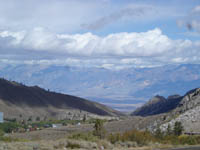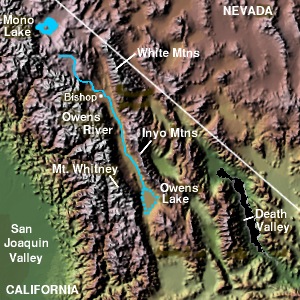OWENS VALLEY
Between 1905 and 1907 most of the land in the Owens Valley was purchased from farmers and ranchers at bargain prices by William Mulholland , superintendent of the Water Department for the City of Los Angeles under the guise of a local irrigation project. Their real goal was to send Owens Valley water south to Los Angeles . By the time the now famous Los Angeles Aqueduct was completed in 1913, it was to late for valley residents to take any action.
prices by William Mulholland , superintendent of the Water Department for the City of Los Angeles under the guise of a local irrigation project. Their real goal was to send Owens Valley water south to Los Angeles . By the time the now famous Los Angeles Aqueduct was completed in 1913, it was to late for valley residents to take any action.
The aqueduct, 223 miles long, used no pumping stations just gravity siphons sending water from the Owens Valley to Southern California . The City of Los Angeles receives 70% of it's water from the Owens Valley and the Eastern High Sierra.
 With the diversion of water to Los Angeles , the Owens Lake and lower Owens River dried up and many valley residents were forced to pack up and leave the area forever. For a number of years, Owens Valley residents expressed much animosity toward the City of Los Angeles as can be seen in Dry Ditches , a little book of poems published in 1934 by the Parcher family of Bishop. The Owens Valley-City of Los Angeles conflict was the subject of the 1974 film Chinatown, starring Jack Nicholson
With the diversion of water to Los Angeles , the Owens Lake and lower Owens River dried up and many valley residents were forced to pack up and leave the area forever. For a number of years, Owens Valley residents expressed much animosity toward the City of Los Angeles as can be seen in Dry Ditches , a little book of poems published in 1934 by the Parcher family of Bishop. The Owens Valley-City of Los Angeles conflict was the subject of the 1974 film Chinatown, starring Jack Nicholson
Novelist Mary Austin lived in Inyo County during this period with her Land Office Registrar husband. She became intimate with the drama that was being played out there. Her novel, The Ford, was, in part, an indictment of the schemers and land-grabbers from Los Angeles.





